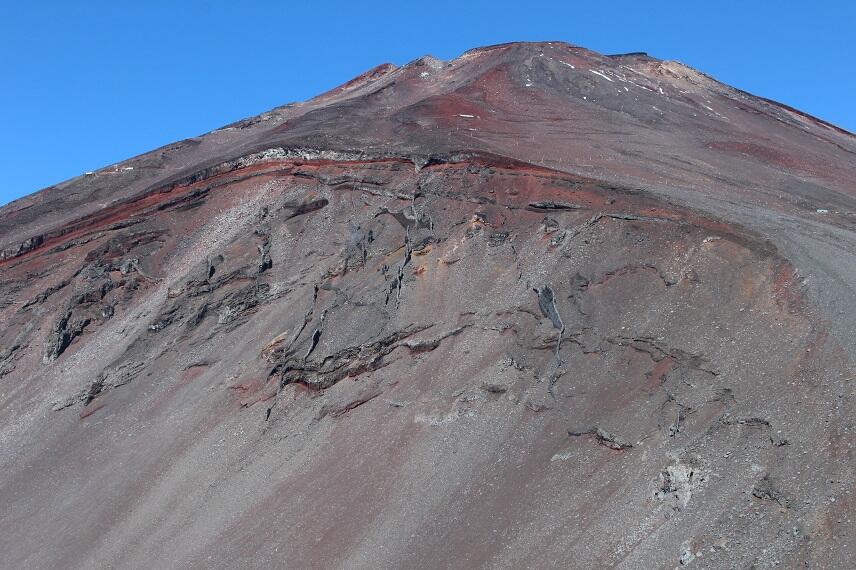Bulletin of the Geological Survey of Japan Top Page
Bulletin of the Geological Survey of Japan Vol.71 No.6 (2020)
Cover photograph | Table of Contents | Abstract
Cover Photo
The Hoei crater of Fuji Volcano
Mt. Fuji is not only the highest mountain in Japan, but also one of the largest active volcanoes in Japan. This crater on the southeastern flank was formed during the 1707 Hoei eruption, since when the volcano has been dormant. The crater wall exposes the piles of volcanic ejecta and dikes. The volcanic ejecta mainly consists of agglutinates (welded fall deposits) interspersed with thin lava flows and fallout scoria. See Yamamoto et al. in this issue for the details of the stratigraphy.
(Photograph and caption by YAMAMOTO Takahiro)
Table of Contents
All the pages PDF : 71_06_full.pdf [20MB]
| Title | Author | |
|---|---|---|
| Article | ||
| Detrital zircon U–Pb age estimated from calcareous sandstone of the Cretaceous Takaoka Formation in eastern margin of the Kanto Mountains | HARA Hidetoshi (p509–516) | 71_06_01.pdf [6MB] |
| Quantitative redescription of the younger pyroclastic fall deposits ejected from Fuji Volcano, Japan | YAMAMOTO Takahiro, NAKANO Shun, ISHIZUKA Yoshihiro and TAKADA Akira (p517–580) | 71_06_02.pdf [24MB] |
| Report | ||
| Grain-size distribution of the postglacial deposits in the Kujukuri Plain, Chiba Prefecture, central Japan | KOMATSUBARA Junko (p581–586) | 71_06_03.pdf [1MB] |
Abstract
Detrital zircon U–Pb age estimated from calcareous sandstone of the Cretaceous Takaoka Formation in eastern margin of the Kanto Mountains
HARA Hidetoshi
U–Pb dating of detrital zircons were analyzed from a calcareous sandstone of the Lower Cretaceous Takaoka Formation, distributed in the eastern margin of the Kanto Mountains. The youngest single grain age and the youngest cluster age were estimated to be 109.7 ± 0.8 Ma and 110.0 ± 1.0 Ma, respectively. Both ages represent the early Albian, suggesting that the Takaoka Formation deposited after the early Albian. In addition, the calcareous sandstone of the Takaoka Formation is characterized by abundant content of Permian to Triassic zircons (276–240 Ma). Based on detrital zircon U–Pb age and sandstone lithology, the Permian to Triassic granitic rocks and the Chichibu accretionary complex were widely distributed in provenance of the Takaoka Formation. The Takaoka Formation corresponds to the Sanyama Formation in the Sanchu Cretaceous System. However, both formations present different peak spectra of detrital zircon U–Pb ages, and are characterized by different provenances.
Quantitative redescription of the younger pyroclastic fall deposits ejected from Fuji Volcano, Japan
YAMAMOTO Takahiro, NAKANO Shun, ISHIZUKA Yoshihiro and TAKADA Akira
The younger Fuji pyroclastic fall deposits since 1,500 cal BC have been re-described with new geochemical data from representative outcrops. And, we measured minimum magma volumes for the fall deposits using the relationship between the area enclosed within an isopach and its thickness. From 1,500 cal BC to 300 cal BC, sub-Plinian eruptions took place at the summit and flanks, and ejected the S-10, Osawa, Omuroyama, S-13, S-18 and S-22 Pyroclastic Fall Deposits whose minimum volumes were about 1 × 10-1 km3 DRE (dense-rock equivalent volume). From 300 cal BC to 1,100 cal AD, all eruptions occurred at the flank, and produced the Gotenbaguchi 1 to 7, Subashiriguchi-Umagaeshi 1 to 7, Yoshidaguchi 1 to 4, Futatsuzuka and S-23 Pyroclastic Fall Deposits, etc., whose minimum volumes were less than 2 × 10-2 km3 DRE. Our revised stratigraphy has suggested that the Subashiriguchi-Umagaeshi 6' Pyroclastic Fall Deposit and the Takamarubi Lava Flow are the products of the Jyohei eruption (AD 937).
Grain-size distribution of the postglacial deposits in the Kujukuri Plain, Chiba Prefecture, central Japan
KOMATSUBARA Junko
Postglacial deposits in four boring cores obtained from the Kujukuri Plain, central Japan, in 2015 were studied with grain size analysis. The results are discussed in terms of sedimentary facies. The majority of transgressive incised-valley deposits consists of mud and coarsens upward to lower shoreface deposits of very fine to fine, well-sorted sand. The proportion of medium, coarse and very coarse sand increases in upper shoreface deposits. The foreshore, backshore and dune deposits consist mainly of very fine and fine sand. The predominance of well-sorted sandy deposits is attributed to the supply of sand reworked from sandy and semi-consolidated Pleistocene nearby.
Geological Survey of Japan, AIST
- About GSJ
- Our Activities
- Purchase guide
-
Publications and Database
- information
- Bulletin of the Geological Survey of Japan
- bull2025(Vol.76)
- bull2024(Vol.75)
- bull2023(Vol.74)
- bull2022(Vol.73)
- bull2021(Vol.72)
- bull2020(Vol.71)
- bull2019(Vol.70)
- bull2018(Vol.69)
- bull2017(Vol.68)
- bull2016(Vol.67)
- bull2015(Vol.66)
- bull2014(Vol.65)
- bull2013(Vol.64)
- bull2012(Vol.63)
- bull2011(Vol.62)
- bull2010(Vol.61)
- bull2009(Vol.60)
- bull2008(Vol.59)
- bull2007(Vol.58)
- bull2006(Vol.57)
- bull2005(Vol.56)
- bull2004(Vol.55)
- bull2003(Vol.54)
- bull2002(Vol.53)
- bull2001(Vol.52)
- Bulletin of the Geological Survey of Japan(old)
- Annual Report on Active Fault and Paleoearthquake Researches
- Reports, Geological Survey of Japan
- CCOP-GSJ Groundwater Project Report
- CCOP Technical Bulletin
- Cruise Report
- Geological Hazards
- Learning and Education
- GSJ Database Collection
- Collection of links


